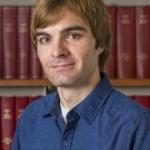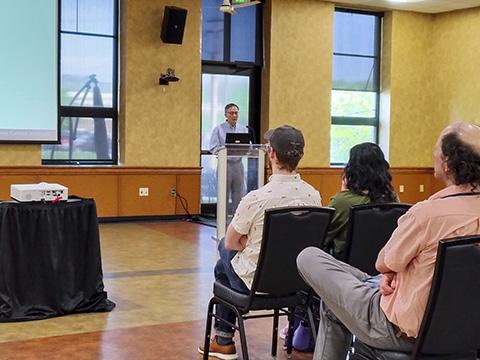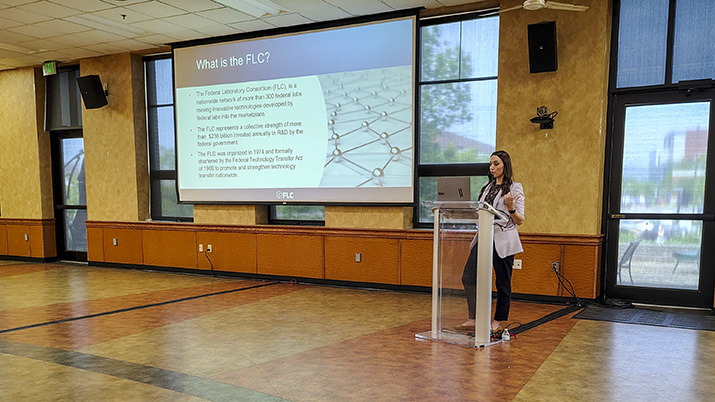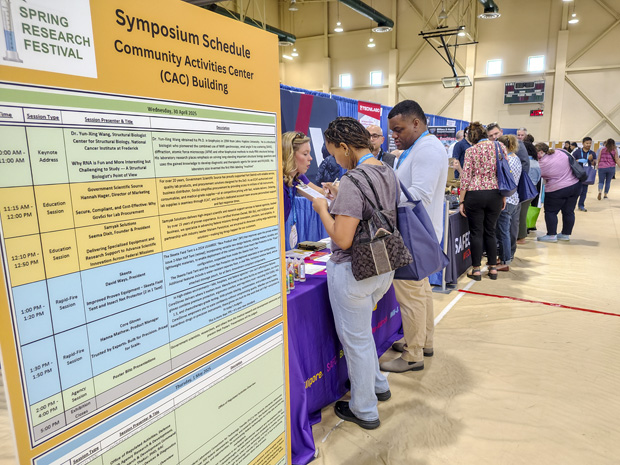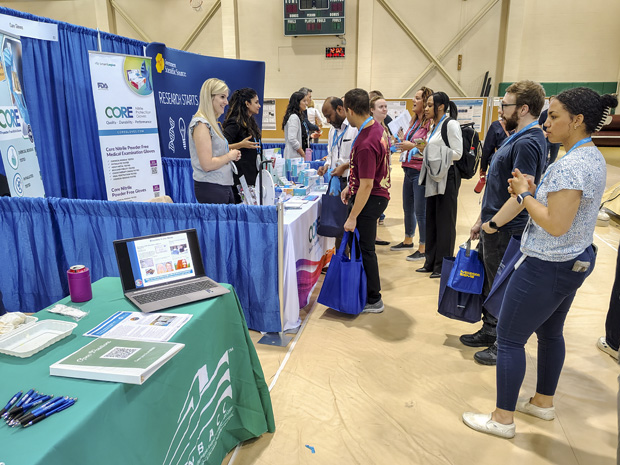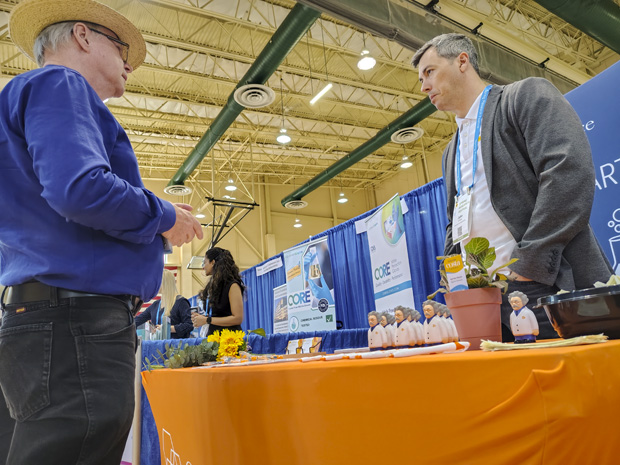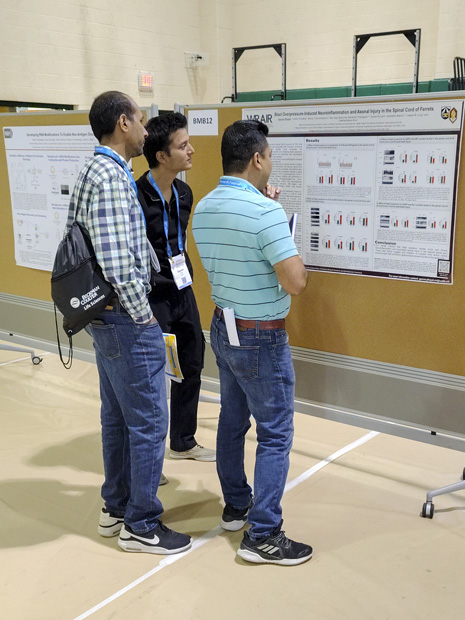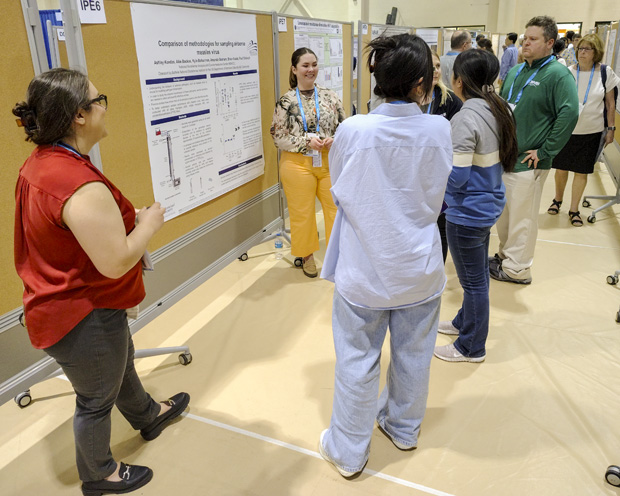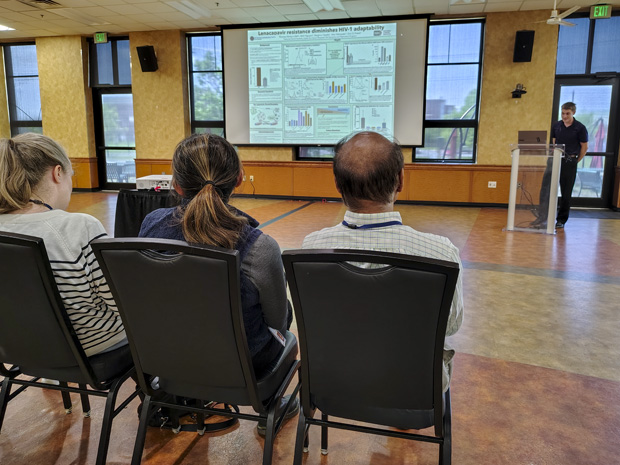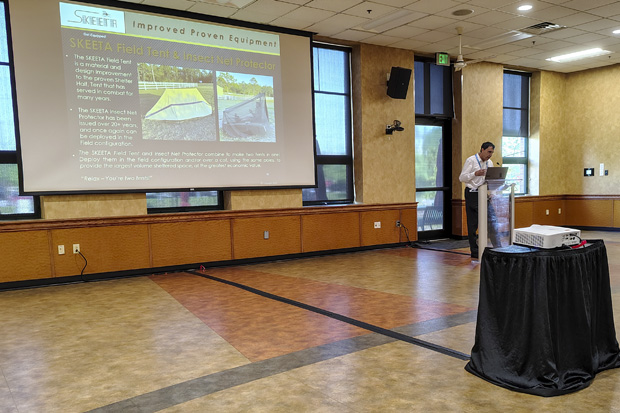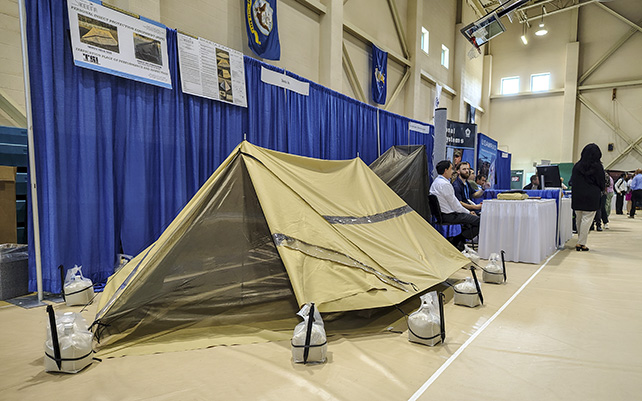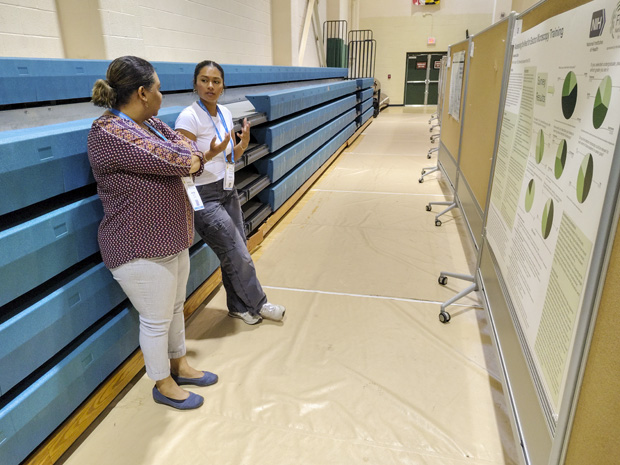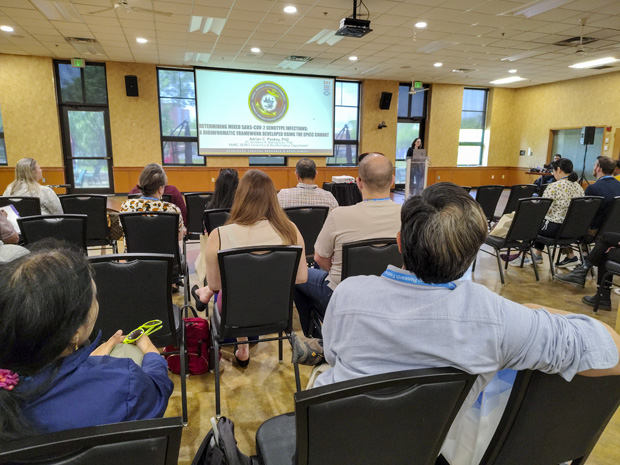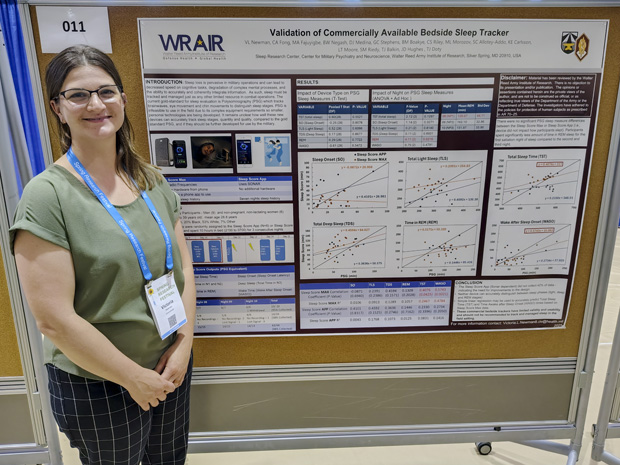It’s three minutes before the keynote at the 2025 Spring Research Festival, and the seats are filling up. Chatter thrums through the room. Somewhere within the stir, someone is talking about tumors. A voice at the back keeps mentioning malaria.
Like the whirl of hushed conversations, the burgeoning audience is an amalgam. Silver-haired senior scientists settle in beside young postdoctoral fellows tacking away on laptops. Military researchers in camo fatigues converse with biologists and administrative specialists dressed in business casual.
Most of them come from the institutions enclosed by Fort Detrick’s fence, though some are attending from federal laboratories in the greater region. For many, their paths are unlikely to cross 363 days out of the year.
Here, though, the two-day festival offers them a break from the routine. Transcending career trajectories, institutional designations, and disciplines, they share their work, witness research from other institutes, and discover new opportunities.
Over two pristine spring days this year, throngs of scientists and specialists poured into the festival and several of its events in numbers markedly higher than recent years. Their participation boosted a collaborative tradition that’s now 28 years old.
Cutting-Edge Effort Could Redefine Understanding
The audience quieted as Yun-Xing Wang, Ph.D., came to the lectern to deliver the keynote.
He’d chosen a topic with relevance across disciplines: an overview of his group’s merging of classic and new techniques to study the 3D structures of RNA.
RNA is inescapable in biological sciences, fundamental in the existence of life itself. Many fields of research either involve it directly or draw from knowledge of its functions.
Yet few 3D RNA structures are known because RNA molecules prove difficult to image with microscopy. Wang, a structural biologist and senior investigator at NCI Frederick, showed the audience how his team has developed cutting-edge tools and algorithms for doing so.
Work that illuminates these structures could redefine our understanding of genetics and basic biology.
“Because the focus of the festival is on innovation and new technologies, it’s truly fitting he gives the keynote,” said Wei-Shau Hu, Ph.D., the NCI Frederick senior investigator who moderated the session.
A Long and Storied Past
In delivering the keynote, Wang wrote another chapter into the Spring Research Festival’s remarkable history. Past years have seen the lectern occupied by microscopy experts, a pandemic response coordinator, the NCI director, even a Nobel laureate.
Tens of thousands of people have passed through the festival since its inception in 1997. Their reasons have been as varied as their backgrounds, from curious students and scientists to public officials wanting to see tax dollars put to work. Their interest shaped the festival into the singular opportunity it now represents, a chance to see and understand federal research, often conducted without fanfare, up close.
The first festivals were humble but boisterous, each a massive event open to the public—yet lacking official status or designation. Scientists shared their findings, but there were also screenings of science movies and discussions that melded science and pop culture.
In time, the festival was named an official event. Its scope became more tailored. Attendance shifted away from the public to scientists and industry professionals, reflecting science’s trend toward specialization in individual disciplines—and scientists’ desire to establish partnerships across these increasingly stark fields.
These days, the festival’s itinerary reads like a national scientific conference in miniature. There’s also a growing emphasis on educational opportunities for participants: one of the festival’s traditional themes receiving ever more favor.
“This really is training,” said Karen Vogel, founder and CEO of Event Performance Group, the event planning company that has helped coordinate the festival in recent years.
Unexpected Connections
Even as the festival has changed, some of its core events have stayed the same, tethering its collaborative spirit.
The poster display, a gallery of posters that summarize researchers’ studies, is one such event—a staple since the first festival. At this year’s display, high school senior and Werner H. Kirsten intern Aleesha Bora got a sense of that spirit.
Bora’s poster, a survey and analysis about electron microscopy training, caught attention she wasn’t expecting. U.S. Army scientists stopped to listen to her explain her research, then remarked she should meet one of their colleagues.
That colleague, an electron microscopy specialist, later visited to speak with Bora—and invite her to apply for an internship with the Army’s research program, a terrific privilege.
“Having someone come individually to see my poster because it’s something that she specializes in and equally believes in the importance of—it was really cool,” Bora said.
‘The Big and the Small’ Picture
For Thomas Abney-Lidahl, a postbaccalaureate fellow at NCI Frederick, the festival was an unbridled learning opportunity. His poster hung alongside the others, but he picked his way through the gallery, studying the mixture of NCI and military research.
“It’s interesting to see what [the military is] working on because we drive past them every single day,” he said.
Abney-Lidahl was also one of the scientists who presented to a nearly full house in the poster blitz, another long-standing festival tradition in which researchers must summarize their work and take questions under a strict time limit.
The blitz aims to stimulate conversations by showcasing a montage of studies in quick succession. Abney-Lidahl impressively commanded his own lecture, and after sitting through the others, he said he was intrigued by the research he saw.
“I think that’s what the advantage of a large research festival—kind of like this where it’s so mixed—is. You get the big and the small [picture]. So, I like that,” he said.
Attendance Exceeds Last Year
The festival’s tableau attracted crowds of others. The vendor exhibition, a convention-style assembly of industry retailers and scientific merchandise, churned with a dull roar. Participants zigzagged between booths, stopping to speak with company representatives and collect brochures and tchotchkes.
Festival attendance well surpassed last year. Pre-registration was six times higher than in 2024, and more participants registered or checked in during the first few hours of this year’s event than during both days last year, said co-coordinator Vogel.
The numbers vindicated years of planning and adjustments that’ve gone into accelerating the festival’s recovery from cancellations and online-only events during the COVID-19 pandemic.
“[This year] has been very well received from everyone, and you can tell. People want to learn. They want to get out. They want to talk to companies to see what they’re doing,” Vogel said.
The surge in attendance came partly from having more staff on-site this year, but the planning team took additional measures, she said.
They placed the poster display and vendor exhibition mere feet from each other to cut down on walking, a callback to past years when both were under an enormous tent outside. Back-to-back lectures and informational sessions filled the schedule between larger symposia. There was always something to do.
Planners also brought in a food truck so participants didn’t need to leave or miss events to have lunch.
But above all, Vogel cited outreach as a leading factor in this year’s success. The team targeted and invited small businesses, first-time participants, and federal laboratories in the region. Many responded favorably.
Surprise Invitation Leads to Good Experience
The invitation was why first-time participant David Ways erected a tent in the vendor exhibition.
He’s the president of Skeeta, Inc., a small, family-run business that produces protective clothing and netting against insects. With his company’s anti-insect tent, his double-wide booth posed a striking contrast to the laboratory vendors who filled much of the expo.
Ways hadn’t heard about the festival, but that changed when he submitted the tent to the Army as part of standard business. A representative called him and encouraged him to use the festival to meet soldiers and military scientists who might be interested in his product.
The suggestion caught Ways off guard. Still, he took it, and standing beside his tent, he tapped into the expo’s air of scientific inquiry by explaining the engineering behind the tent’s lightweight design.
Even just a few hours in, he was already happy with the experience, he said.
“Hopefully we’ll get to enjoy another festival in Frederick in the future,” he said.
Clarity and Connection Remain Big Draws
Visitors from institutes beyond Fort Detrick also seemed pleased with the festival.
First-time participants Victoria Newman and Tracy Jill Doty, Ph.D., were two of them. Part of a crowd of researchers who’d driven in from Walter Reed Army Institute of Research in Silver Spring, they’d come to share their findings and see what scientists at Fort Detrick were up to.
“Being able to see what the local research environment can offer and being able to connect with vendors and other researchers and collaborate with other labs, I think this is a really good opportunity,” Newman said.
Newman, a regulatory compliance specialist currently on detail as a researcher with Doty’s team, spent a festival day reporting on the results of a military sleep study. The team had evaluated a commercial device and app for tracking sleep quality in special operations forces.
That sort of study can be uncommon at NCI and Fort Detrick, where research often focuses on cancer and infectious diseases. For Doty’s group, participating in the festival meant a chance to offer clarity while gaining experience in presenting their work.
“I think it’s just one of those opportunities that we should not let go of,” Doty said.
It was, in essence, what brought participants to the first festival 28 years ago—and it’s still going strong.
“We will absolutely be back,” Doty said.


